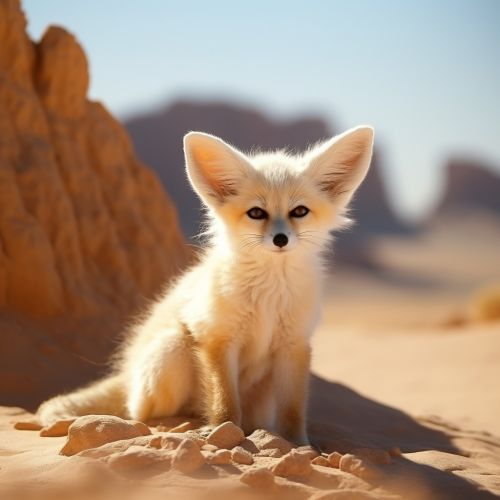Vulpes zerda
Taxonomy and Evolution
The Vulpes zerda, commonly known as the fennec fox, is a small canid species native to the Sahara and other arid regions of North Africa. It is the smallest species of the family Canidae, which also includes other fox species, wolves, jackals, and domestic dogs. The fennec fox is classified under the genus Vulpes, which comprises twelve species including the red fox (Vulpes vulpes) and the Arctic fox (Vulpes lagopus).
The fennec fox is believed to have evolved in the arid regions of North Africa, adapting to the harsh desert environment over millions of years. Its small size, large ears, and other distinctive features are the result of adaptive evolution, a process where organisms gradually change in response to environmental pressures.


Description
The fennec fox is renowned for its distinctive physical characteristics, which include its unusually large ears, small size, and sandy-colored coat. These features are all adaptations to the fox's desert environment. The fox's large ears, which can be as long as 15 cm, serve a dual purpose: they enhance the fox's hearing, allowing it to detect prey moving underground, and they also help to dissipate heat, keeping the fox cool in the hot desert climate.
The fennec fox typically weighs between 0.68 to 1.59 kg and stands around 20.3 cm tall at the shoulder, with a body length of up to 40 cm. Its coat is thick and provides excellent insulation against the cold desert nights, while its sandy color helps the fox blend into its environment, providing camouflage against predators.
Behavior and Ecology
Fennec foxes are highly adapted to their desert environment. They are nocturnal, which allows them to avoid the intense heat of the day. During the day, they shelter in burrows, which they dig in the sand. These burrows can be quite complex, with multiple entrances and chambers.
Fennec foxes are omnivorous, feeding on a variety of foods including insects, small mammals, birds, eggs, and plant matter. Their large ears help them locate prey underground, and they have been observed to leap high into the air to pounce on prey, a behavior known as 'mousing'.
Despite their small size, fennec foxes are quite territorial and will defend their territories fiercely. They communicate with a variety of vocalizations, including barks, howls, and whines.
Reproduction
Fennec foxes are monogamous, with pairs forming strong bonds. The breeding season typically occurs between January and March, with the female giving birth to a litter of two to five pups after a gestation period of around 50 days. The male assists in caring for the pups, bringing food to the den and helping to defend the territory.
Conservation Status
The fennec fox is currently listed as 'Least Concern' on the IUCN Red List, due to its wide distribution and presumed large population. However, the species faces threats from habitat loss due to desertification and human encroachment, as well as from hunting and trapping for the pet trade.
